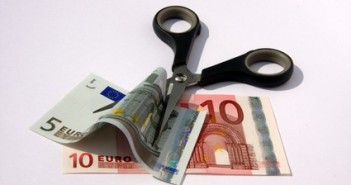Each ECB decision is important for the euro, but this one has even elevated expectations, triggered by the ECB itself in the previous meeting: Draghi’s hint of action in June already sent EUR/USD a few hundreds of pips lower and now tension is mounting towards the moment of truth.
What will the ECB actually do? What will Draghi announce and what is already priced in? Here is some background, 6 potential policy options and 5 scenarios for the big event.
Update: ECB sets historic negative rate and promises more – EUR/USD crashes
Update 2: ECB Live Blog: Draghi to deliver even more
Analysis: Did Draghi make a critical mistake with forward guidance?
Background
Lowflation / deflation
The ECB has a “single needle in the compass”: an inflation rate of 2% or a bit below in headline inflation. The target is being missed month after month. The low inflation, or “lowflation” is with us since the big fall in October – the drop to 0.7% triggered a rate cut in November.
Low inflation makes the debt burden harder and brings deflation closer. Falling prices are not all positive: when consumers expect them to fall, they don’t buy, factories produce less, lay out workers and there is less disposable income to buy goods, etc. The ECB would not like to see this vicious cycle that Japan experienced for two decades.
The ECB denied the imminent danger of deflation but did acknowledge that prolonged low inflation is dangerous as well, and harder to get out of.
Fresh flash data from May shows that headline CPI fell to 0.5% y/y and core inflation to 0.7%. These numbers were already seen in March and for core inflation, they haven’t been seen for years, not even during the peak of the financial crisis.
The exchange rate
One of the reasons for the low inflation is the exchange rate: a strong euro means less attractive exports (thus weighing on companies and jobs) and cheaper imports (pushing prices lower). Each time EUR/USD got too close to 1.40, the ECB acted to talk it down.
Yet it isn’t only the story of EUR/USD, but also EUR/CNY: after a long period of appreciation for the Chinese yuan, the authorities in the world’s second largest economy began pushing the yuan lower against the US dollar, thus pushing EUR/CNY much higher. China is an important trade partner of the euro-zone in general and Germany in particular.
Verbal attempts
Mario Draghi and his colleagues attempted to push down the value of the euro in escalating commentary: technical readiness to introduce a negative deposit rate was used several times. Forward guidance to keep rates low or lower for a long time followed. In April, the statement that Draghi read included a statement that the ECB is “unanimous regarding the option to use unconventional monetary tools“. And his last move before the previous press conference was to explicitly tie between monetary policy and the exchange rate.
In a perfect world, he would lower the value of the euro without having to act, leaving all the unconventiaonl ammunition at hand. The interest rate is already at 0.25%. He managed to do that with the “do whatever it takes” speech in the summer of 2012 when he single handedly saved the euro from brink of collapse.
All these attempts had a temporary effect. Talk became cheap and each statement had a diminishing effect.
Until May 8th
In the previous rate decision, Draghi said that the governing council feels comfortable to act in June, assuming that the staff projections awaiting in June point to lower inflation.
The outcome was swift: EUR/USD had already traded just a few pips away from 1.40. The pair immediately changed course and tumbled down over 150 pips. It then continued lower and reached a bottom of 1.3585 at the time of writing.
Not only has this move lowered the value of the euro, but it finally seems to have stopped the “buy the dips” behavior of EUR/USD and has also slowed down or even halted the drop in bond yields of peripheral countries.
Was this the ultimate play by the former Goldman Sachs executive? Just another successful bluff that would lower the value of the euro without action?
Not exactly: Draghi and his colleagues repeated the heavy hints in many public appearances. They tied themselves to action. In addition, both EUR/USD and EUR/CNY are still too high: a fall of 2.5% is significant, but can be easily reversed.
Can the ECB staff projections point to any other outcome than a worsening inflation outlook? Not really.
A failure to deliver would send EUR/USD shooting higher and undermine the credibility of the institution.
Part 2:
Let’s see what Draghi and co. can deliver, what is priced in and what could happen.
